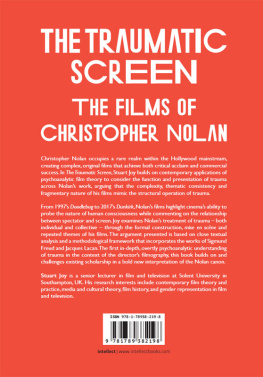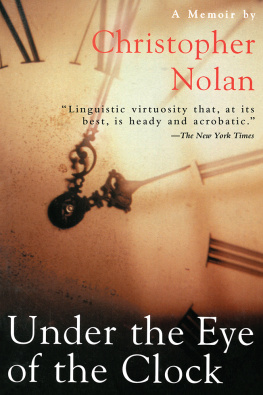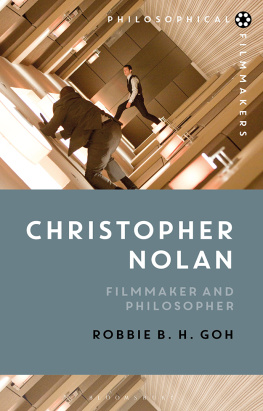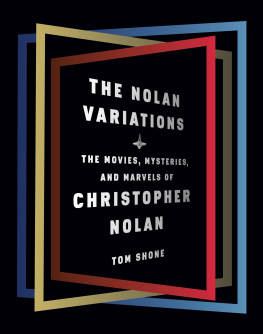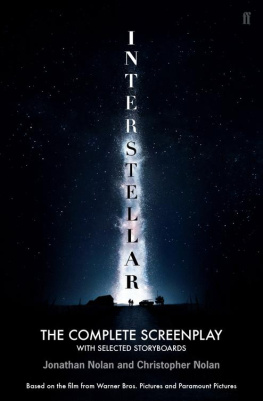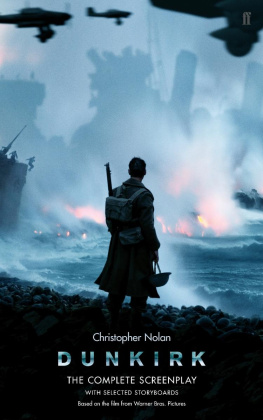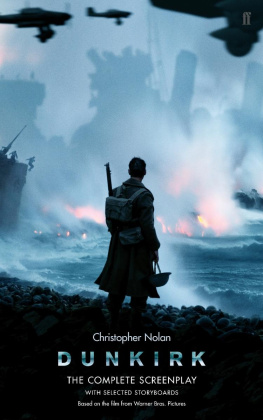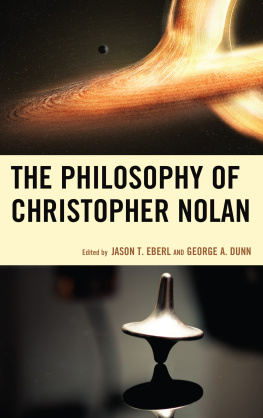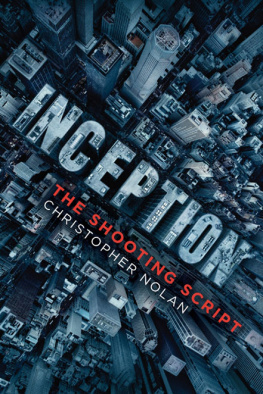Stuart Joy - The Traumatic Screen: The Films of Christopher Nolan
Here you can read online Stuart Joy - The Traumatic Screen: The Films of Christopher Nolan full text of the book (entire story) in english for free. Download pdf and epub, get meaning, cover and reviews about this ebook. year: 2020, publisher: Book Network Intl Limited trading as NBN International (NBNi), genre: Romance novel. Description of the work, (preface) as well as reviews are available. Best literature library LitArk.com created for fans of good reading and offers a wide selection of genres:
Romance novel
Science fiction
Adventure
Detective
Science
History
Home and family
Prose
Art
Politics
Computer
Non-fiction
Religion
Business
Children
Humor
Choose a favorite category and find really read worthwhile books. Enjoy immersion in the world of imagination, feel the emotions of the characters or learn something new for yourself, make an fascinating discovery.
- Book:The Traumatic Screen: The Films of Christopher Nolan
- Author:
- Publisher:Book Network Intl Limited trading as NBN International (NBNi)
- Genre:
- Year:2020
- Rating:3 / 5
- Favourites:Add to favourites
- Your mark:
- 60
- 1
- 2
- 3
- 4
- 5
The Traumatic Screen: The Films of Christopher Nolan: summary, description and annotation
We offer to read an annotation, description, summary or preface (depends on what the author of the book "The Traumatic Screen: The Films of Christopher Nolan" wrote himself). If you haven't found the necessary information about the book — write in the comments, we will try to find it.
Stuart Joy: author's other books
Who wrote The Traumatic Screen: The Films of Christopher Nolan? Find out the surname, the name of the author of the book and a list of all author's works by series.
The Traumatic Screen: The Films of Christopher Nolan — read online for free the complete book (whole text) full work
Below is the text of the book, divided by pages. System saving the place of the last page read, allows you to conveniently read the book "The Traumatic Screen: The Films of Christopher Nolan" online for free, without having to search again every time where you left off. Put a bookmark, and you can go to the page where you finished reading at any time.
Font size:
Interval:
Bookmark:



First published in the UK in 2020 by Intellect, The Mill, Parnall Road, Fishponds, Bristol, BS16 3JG, UK
First published in the USA in 2020 by Intellect, The University of Chicago Press, 1427 E. 60th Street, Chicago, IL 60637, USA
Copyright 2020 Intellect Ltd
All rights reserved. No part of this publication may be reproduced, stored in a retrieval system, or transmitted, in any form or by any means, electronic, mechanical, photocopying, recording, or otherwise, without written permission.
A catalogue record for this book is available from the British Library.
Cover designer: Aleksandra Szumlas
Copy editor: MPS Technologies
Production manager: Emma Berrill
Typesetting: Contentra Technologies
Print ISBN 978-1-78938-202-0 (hardback)
Print ISBN 978-1-78938-219-8 (paperback)
ePDF ISBN 978-1-78938-204-4
ePub ISBN 978-1-78938-203-7
Printed and bound by Print on Demand, United Kingdom
To find out about all our publications, please visit www.intellectbooks.com.
There, you can subscribe to our e-newsletter, browse or download our current catalogue, and buy any titles that are in print.
This is a peer-reviewed publication.
Dedicated with love to my parents
Take a moment to consider your achievement
Cutter, The Prestige
First, I would like to thank Dr Jacqueline Furby and Dr Claire Hines for their unwavering support and encouragement. You have both been a constant source of thoughtful advice, calm reassurance and intellectually stimulating conversation over the years. Without both of you, I simply would not be where I am today. Likewise, I would like to express my gratitude to Professor Edward Chaney, Professor Maurice Owen and Professor Karen Randell for their helpful guidance. Sincere thanks are extended to Darren Kerr, Paul Marchbank and Professor Rod Pilling for their financial and institutional support while writing this book. I would also like to thank several scholars including Dr Donna Peberdy, Dr Devon Campbell-Hall, Professor Will Brooker, Dr Sorcha N Fhlainn, Dr Francesca Brencio, Dr Erin-Hill Parks, Dr Frances Pheasant-Kelley, Dr Tony M. Vinci and Dr Paul Sutton who have all contributed, in various ways, to the development of my ideas. I would particularly like to thank Dr Terence McSweeney whose feedback and guidance have been invaluable. Special thanks to my friend Kierren Darke for his willingness to act as a sounding board for my ideas and lastly, very special thanks are due to my family and my wife Sophie Joy Cross for their kindness, understanding and patience.
Ive done really well so far in my career by trusting the audience to be as dissatisfied with convention as I am.
Christopher Nolan (2010: 18)
Trauma haunts the cinema of Christopher Nolan. Beginning with his short film Doodlebug (1997) and ending with Dunkirk (2017), his films strive to articulate and understand the complexities of trauma. His recurring interest in aligning us with characters who have been traumatized and his repeated return to stories that involve loss thematically anchors each of his films in the experience of trauma. But beyond this, trauma is also explored through our own relationship to his films which frequently feature complex timelines that demand and even reward multiple viewings. These intricate narrative puzzles encourage us to return to them in such a way that emulates the cognitive shifts of traumatic memory just as those who have undergone a traumatic experience must remember the past in the hope of moving forward, we too must recall our experience if we are to understand what we have seen. Take, for example, Nolans debut feature Following (1998). In this film, our own experience of trying to make sense of the discontinuous episodic timeline is paralleled by the protagonists inability to comprehend how he is framed for murder by the mysterious stranger Cobb (Alex Haw). In Memento (2000), the non-linear narrative functions to place the audience in the shoes of Leonard Shelby (Guy Pearce), a man with no short-term memory who seeks vengeance for the rape and murder of his wife. Likewise, in Insomnia (2002), Detective Dormers (Al Pacino) own actions are the result of a traumatic event that subtly disrupts the linear chronological order of the film from the outset. Elsewhere, Nolans turn to the superhero film with Batman Begins (2005) and its sequels, The Dark Knight (2008) and The Dark Knight Rises (2012), places an emphasis on Bruce Waynes (Christian Bale) childhood and in doing so proves to be fertile ground for the exploration of the characters traumatic past via flashbacks and other temporal slippages. As with a number of other films directed by Nolan including Memento and Insomnia, in The Prestige (2006) and later Inception (2010), it is principally a woman, or more precisely the death of a woman, that fractures the narrative structure and provides an insight into how trauma is manifested in these films. This trend continues in Interstellar (2014) although, in this instance, allusions to the death of Coopers (Matthew McConaughey) wife serve as the necessary backdrop for exploring his strained relationship with his children whom he is forced to abandon in a story that involves actual time-travel. Finally, in Dunkirk, it is the trauma of battle that underpins the fragmented narrative of a group of soldiers desperately trying to flee the beaches of Northern France amid the Second World War.
The way that trauma is handled in these films corresponds to widely agreed-upon definitions of trauma as an overwhelming response to an unexpected event that can be neither fully understood nor fully assimilated but rather acquires significance after the fact in its repetition (Caruth 1996: 4). This emphasis places these films at the intersection between cinema and psychoanalysis and so my principle focus in this book is how Nolan attempts to represent trauma and how the spectator encounters it primarily in relation to a psychoanalytical framework. Indeed, it seems to me that it is important to move beyond an understanding of these films as being a simple way of attempting to represent trauma and consider instead how trauma is vicariously experienced that is, how Nolans films speak to the spectator. Before proceeding any further, then, it is worthwhile at this stage to qualify my own engagement with trauma. While much of what I go on to discuss involves identifying a signifier for the experience of trauma whether that be Cobbs (Leonardo DiCaprio) involvement in his wifes death in Inception or Coopers attempts to alleviate the guilt attached to his choice to abandon his children in Interstellar I am less interested in the individual event than I am in suggesting that the pathology of the traumatic experience should not be defined by the event itself or the distortion of that event, but rather by the structure of the experience. In the context of Nolans films, this experience is evident not only in terms of form and content through a series of visual and narrative repetitions but also through the spectators engagement with each of his films. I am arguing that Nolans films not only contain attempts to represent traumatic events, but also that our experience of these films means that they can be understood as a distinct form of trauma cinema.
Font size:
Interval:
Bookmark:
Similar books «The Traumatic Screen: The Films of Christopher Nolan»
Look at similar books to The Traumatic Screen: The Films of Christopher Nolan. We have selected literature similar in name and meaning in the hope of providing readers with more options to find new, interesting, not yet read works.
Discussion, reviews of the book The Traumatic Screen: The Films of Christopher Nolan and just readers' own opinions. Leave your comments, write what you think about the work, its meaning or the main characters. Specify what exactly you liked and what you didn't like, and why you think so.

